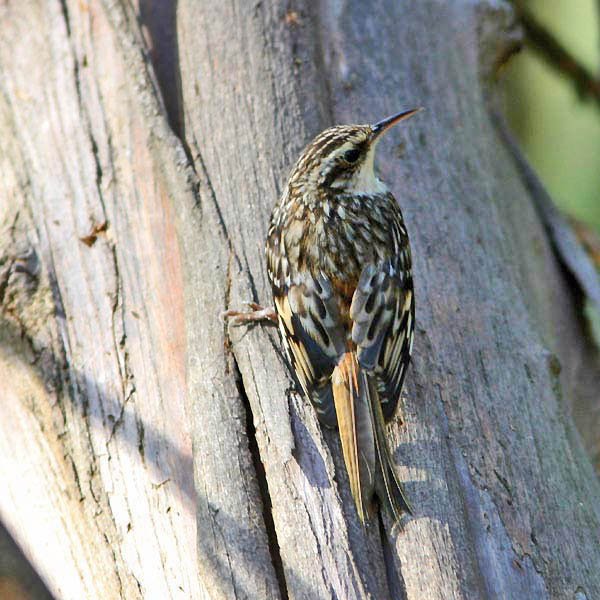
a web page by Don Roberson |
TREECREEPERS Certhiidae |
|
A pair resides in my backyard on the central California coast. I've been trying for years to get a photo of these birds but the adults are always wary. This shot (left) is about as close as I could get. This past summer, though, one the pair's offspring did not recognize me as a threat and, in fact, it landed on the rail that surrounds the patio (below). Although not noticeable in these photos, the local race on the central California coast has its underparts washed with a much darker gray-brown than other western U.S. subspecies, and has been formally named phillipsi (Unitt & Rea 1997). Its small range extends from San Mateo County south to Santa Barbara County, with its core population in Monterey County. |

|
This Eurasian Treecreeper (left, in a lovely shot by Graham Catley) was in northern England but is not the British race britannica. Rather, the broad snowy-white supercilium and pure-white underparts suggest this is the nominate race familiaris, which ranges from Scandinavia to western Siberia, and is a rare vagrant to the U.K.
|
Harrap & Quinn (1995) write of the habits of Eurasian Treecreeper but it applies equally well to Brown Creeper in North America and, perhaps, to Himalayan species: "Often tame and, indeed, indifferent to man, although it has the annoying habit of moving to the side of the tree trunk invisible to the observer, and altogether inconspicuous and unassuming, neither plumage nor voice demanding attention in the way of most tits and nuthatches. Typically found singly in winter, sometimes in pairs (the pair-bond apparently sometimes persists outside the breeding season, or in some regions pairs may be established in the autumn), and very often joining mixed-species foraging flocks. The breeding pair occupies a home range, and the area around the nest is apparently defended by the male as a nesting territory, usually with song." Unlike nuthatches, which check cracks in bark for insects by moving mostly downwards on a trunk or limb, treecreepers forage up a tree-trunk, using the stiff, sturdy tail as a prop. When a treecreeper gets high into a tree, it typically fly down to the base of the next tree and work upwards again. |
Photos: The two photos of Brown Creeper Certhia americana phillipsi were taken in my yard in Pacific Grove, Monterey Co., California, on 10 Apr 2005 (adult) and 7 June 2015 (juv), respectively. The Eurasian Treecreeper C. familiaris familiaris was photographed by Graham Catley in Lincolnshire, England, on 19 Oct 2015. Bibliographic note:
Literature cited:
|
 Treecreepers are a small family of small birds, the vast majority of which inhabit coniferous and riparian forests in North America and Eurasia. Ten of the dozen species are in the single genus Certhia, and all rather resembling each other. This one is the widespread North American Brown Creeper (left). Most of the species are non-migratory and retain similar camouflaged plumages throughout the year.
Treecreepers are a small family of small birds, the vast majority of which inhabit coniferous and riparian forests in North America and Eurasia. Ten of the dozen species are in the single genus Certhia, and all rather resembling each other. This one is the widespread North American Brown Creeper (left). Most of the species are non-migratory and retain similar camouflaged plumages throughout the year.  Nine of the 11 species in this family in the genus Certhia — called 'treecreepers' in Eurasia and 'creepers' in North America — and overall the nine species are very similar in aspect, differing only slightly in size, underparts coloration, tail and rump color (or barred tail in one species), and in vocalizations. Eurasian Treecreeper has a very wide range from Europe to Japan; Short-toed Treecreeper C. brachydactyla is a similar species in continental Europe; and the remaining six species inhabit varying elevational ranges in the Himalayas, in mountains of northeast India and Myanmar, and in the mountains of China.
Nine of the 11 species in this family in the genus Certhia — called 'treecreepers' in Eurasia and 'creepers' in North America — and overall the nine species are very similar in aspect, differing only slightly in size, underparts coloration, tail and rump color (or barred tail in one species), and in vocalizations. Eurasian Treecreeper has a very wide range from Europe to Japan; Short-toed Treecreeper C. brachydactyla is a similar species in continental Europe; and the remaining six species inhabit varying elevational ranges in the Himalayas, in mountains of northeast India and Myanmar, and in the mountains of China. 